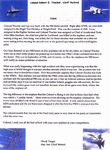kool kitty89
Senior Master Sergeant
So did all tanks cause high-speed problems or just the centerline 233 gal tanks. The F-80Cs used both the centerline tanks as well as 265 US gallon under-tip tanks (sometimes named "Misawa" tanks) see: Lockheed P-80C Shooting Star
Quote from Lockheed XP-80A Shooting Star : "The second XP-80A became the first in the Shooting Star series to carry a 165 US-gallon drop tank underneath each wingtip. When carried, these tanks actually lowered rather than increased the drag. They could be brought home empty with no penalty in aerodynamic drag. The tanks also improved aileron effectiveness and wing loading."
So was it just the early 165 gallon tanks that had this possitive effect?
Below is a comparison of the tanks from: BVM T-33 Jet Kit
Below that is an interesting story of the P-80 found on the same site: Hot Shots BVM F-80 Shooting Star
Some cool cool model flight there, I wonder if there are any like Me-262 models?
Quote from Lockheed XP-80A Shooting Star : "The second XP-80A became the first in the Shooting Star series to carry a 165 US-gallon drop tank underneath each wingtip. When carried, these tanks actually lowered rather than increased the drag. They could be brought home empty with no penalty in aerodynamic drag. The tanks also improved aileron effectiveness and wing loading."
So was it just the early 165 gallon tanks that had this possitive effect?
Below is a comparison of the tanks from: BVM T-33 Jet Kit
Below that is an interesting story of the P-80 found on the same site: Hot Shots BVM F-80 Shooting Star
Some cool cool model flight there, I wonder if there are any like Me-262 models?



